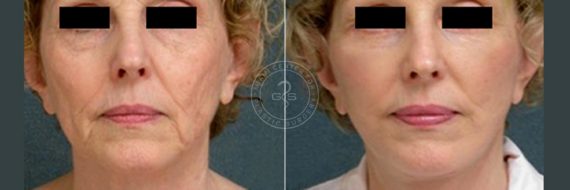
Are you considering a facelift but unsure about the various techniques and which might be right for you? The SMAS facelift, a method that targets the deeper layers of facial structure, could offer more durable and natural-looking results compared to traditional methods.
Dr. Gabe Salloum specializes in facial rejuvenation and employs the SMAS technique to treat signs of aging. His knowledge of facial anatomy enables him to tailor each procedure to the specific characteristics of the individual, aiming to restore a youthful look.
How a SMAS Facelift Can Help You Look and Feel Younger
- An SMAS facelift addresses the deeper layers of the facial skin for a more lasting effect.
- This procedure not only lifts the face but also incorporates a neck lift, removing loose skin for enhanced facial contours.
- The cost of an SMAS facelift is aligned with the intricate nature of the surgery.
- Designed to provide long-lasting results, improving both facial structure and appearance.
- Achieving exceptional results requires a highly skilled surgeon, such as Dr. Gabe Salloum, who ensures both safety and aesthetic precision.
What is the SMAS and its Role in Facial Aging?
The SMAS is composed of fibrous tissues that encapsulate the facial muscles. It connects with the skin and supports the facial structure, influencing facial expressions and the shape of the cheeks and jowls.
As the SMAS ages, it becomes less elastic, leading to sagging in areas such as the cheeks and jowls. This is why SMAS facelift procedures, which tighten and adjust this layer, play an important role in improving facial appearance. Unlike traditional facelifts that target the surface, an SMAS facelift rearranges deeper tissues for more enduring results.
The SMAS Facelift Technique Explained
The SMAS facelift uses a specific method to preserve the health of the facial and neck muscles. The process starts by separating the SMAS, which includes the facial and neck muscles, from the underlying layers.
Steps in the SMAS Facelift
- Dissection: Surgeons carefully isolate the superficial musculoaponeurotic system or SMAS from the other structures beneath it.
- Repositioning: Next, the SMAS layer is adjusted to target sagging and to recreate the facial contours associated with youth.
- Tightening: The last step is to secure the repositioned SMAS Facelift, aiming for durable outcomes from this sophisticated facelift technique.
Each phase of the SMAS Facelift is performed with attention to detail to ensure the structure of the underlying muscles and tissue is preserved.
Facelift Before and After Pictures


*All patients are unique and individual results may vary.
Comparing SMAS Facelift with Traditional Facelift
A SMAS facelift targets the Superficial Musculoaponeurotic System beneath the skin. It lifts the underlying muscles, resulting in a more natural appearance. In contrast, a traditional facelift tightens the skin to diminish signs of aging. The SMAS facelift provides long-lasting results by repositioning deeper facial tissues. On the other hand, a traditional facelift may have shorter-lasting effects. A deep plane facelift, which is related to the SMAS method, offers even greater longevity for individuals with hollow cheeks.
- SMAS Facelift: targets deeper structures, improves hollow cheeks, offers long-lasting results, and repositions muscles.
- Traditional Facelift: tightens skin, less effect on hollow cheeks, shorter-lasting results.
Choosing between a SMAS facelift and a traditional facelift depends on individual aging symptoms and goals. Both types of facelift surgery require expertise for optimal outcomes.
Candidates for SMAS Facelift
Ideal candidates for SMAS facelift surgery are individuals seeking to address signs of aging in the deeper layer of tissue, such as sagging cheeks and jowls. These individuals may have concerns about loss of facial volume and are looking for a surgical technique that provides long-lasting results.
Potential candidates need to consult with experienced facial plastic surgeons who have a comprehensive understanding of the SMAS layer and its role in cosmetic surgery. During facelift consultations, the surgeon will assess the individual patient’s specific needs and determine if they are suitable for this procedure. Understanding the risk of complications and the importance of the healing process is vital for ensuring a successful outcome from SMAS facelift surgery.
The Pre-operative Evaluation Process
Physical Exam and Medical History
The initial step in the pre-operative evaluation for an SMAS facelift involves a thorough physical examination and medical history review. This process determines eligibility for the procedure and identifies any health concerns that could affect recovery. Important factors like skin elasticity and facial structure, particularly in areas with wrinkles, are evaluated for facelift surgeries.
Expectations and Outcomes
Understanding patients’ aesthetic goals is crucial for a SMAS facelift. A discussion helps ensure that patients’ goals are achievable and guides the facelift to enhance the patient’s look naturally.


SPECIALIST CARE YOU CAN TRUST
Dr. Salloum is supported by a brilliant team of caring staff members.
You can trust the entire staff to help make your visit as comfortable and safe as possible!
The SMAS Facelift Procedure
Incision Techniques
The SMAS Facelift starts with an incision around the ear contours, extending into the hairline to hide scars and provide access to the underlying SMAS layer.
Manipulating the SMAS Layer
The surgeon then elevates the SMAS layer, improving sagging tissues and defining the jawline while softening nasolabial folds. This is akin to the technique used in a deep plane facelift as the SMAS is repositioned to achieve a lasting effect.
Skin Redraping
The skin is then smoothly re-draped over the adjusted SMAS layer. To accommodate the new shape, excess skin and any extra skin are trimmed. The skin is then held in place with sutures or adhesives, avoiding over-tightening for a natural look.
- A discreet incision is made for minimal scarring
- SMAS layer tightened to restore facial structure
- Skin redraped and secured with suture or adhesives for a smooth finish
Recovery Timeline and What to Expect Post-Surgery

After an SMAS facelift, it’s important to take good care of yourself right after surgery. Watch for any signs of blood problems or infections, and try to keep your head elevated to help with swelling. Follow your pain management plan and take care of the surgical sites. Be careful with physical activities and make sure to get plenty of rest. Most people can return to their regular activities within 2-3 weeks as the swelling goes down.
However, the journey towards facial rejuvenation extends over months, characterized by a gradual return to strenuous activities, continual improvements in swelling and skin tone, and diligent skincare practices, including sun protection. Adhering closely to medical guidance is imperative for a successful rejuvenation, as the full benefits manifest gradually, culminating in a rejuvenated appearance over several weeks.
Potential Risks and Complications Associated with SMAS Facelift
SMAS facelifts and other surgical procedures come with potential risks. These can include:
- Bleeding under the skin, leading to bruising.
- Swelling after the procedure.
To handle these risks associated with facelift surgery:
- Avoid strenuous activities during recovery.
- Surgeons should use precise methods to prevent blood accumulation.
- Regular monitoring is necessary for quick response to any complications.
Choosing Dr. Gabe Salloum for the SMAS Facelift
Choosing a skilled surgeon is essential when considering an SMAS facelift. Dr. Gabe Salloum has extensive experience in this specialized procedure. He understands the superficial musculoaponeurotic system (SMAS) well. This knowledge is crucial for lifting sagging cheeks and creating a rejuvenated look. Patients can trust Dr. Salloum’s meticulous care and personalized approach. This contributes to successful outcomes in SMAS facelift procedures.
Maintenance of SMAS Facelift Results
Adopting a skincare routine post-SMAS Facelift is essential for maintaining results. Protection against sagging and deep wrinkles involves products that bolster skin elasticity and collagen. A skincare specialist can provide tailored advice.
Embracing a healthy lifestyle also influences the longevity of facelifts. A balanced diet, regular exercise, and steering clear of smoking can help sustain the youthful effects of the procedure. Being mindful of the costs, these practices contribute to the lasting success of a deep plane facelift.
Take the first step towards a confident future. Schedule a consultation with Dr. Salloum for personalized insights and a tailored approach to your facial rejuvenation. Your path to natural-looking vitality begins with expert care.